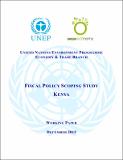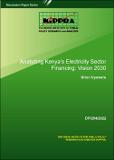Discussion Paper No. 129 of 2012 on The Relationship Between Electricity Consumption and Output in Kenya's Manufacturing Sector
Publication Date
2012Author
Type
Discussion Paperviews
downloads
Metadata
Show full item recordBy
Karumba, Mary
Abstract/
This study investigates the relationship between electricity consumption and output produced by the manufacturing sector in Kenya, while accounting for fixed investment, employment (labour), and prices of oil and electricity. Data for the period 1970-2008 was utilized, a multivariate analysis was carried out based on a VECM, because although the series were unit root processes, they were found to be integrated of first order, hence co-integration, and some of the variables of the study were endogenous. The study shows unidirectional causal relationship running from output of the manufacturing sector to electricity consumption, leading to the conclusion that information about the extent of the manufacturing sector is important in predicting the amount of electric power used by the sector. Additionally, the results imply that the manufacturing sector in Kenya is not electricity-dependent, and a shock in power consumption will not lead to a significant change in the output. The results of the study are consistent with Wolde-Rufael (2009) who found that a unidirectional relationship running from economic growth to electricity consumption exists in Cameroon, Ghana, Nigeria, Senegal, Zimbabwe and Zambia. The results, however, contradict those of Soytas and Sari (2007), who found a unidirectional relationship running from energy consumption to economic growth in the Turkish manufacturing industry.
Subject/
Electricity Consumption; Electricity output; Manufacturing Sector; Energy Sector; Kenya
Publisher
The Kenya Institute for Public Policy Research and Analysis (KIPPRA)Series
DP/129/2012;Collections
- Discussion Papers [346]
Related items
Showing items related by title, author, creator and subject.
-
Working Paper of 2015 on Fiscal Policy Scoping Study Kenya
United Nations Environment Programme (UNEP) (The Kenya Institute for Public Policy Research and Analysis (KIPPRA), 2015)A recent green economy assessment report (UNEP, 2014) on Kenya reveals that the transition to a green economy can deliver important benefits, such as long-term economic growth, a cleaner environment and high productivity. ... -
Discussion Paper No 294 of 2022 on Analyzing Kenya’s Electricity Sector Financing: Vision 2030
Nyaware, Brian (The Kenya Institute for Public Policy Research and Analysis (KIPPRA), 2022)Electricity plays a crucial role in improving livelihoods and enabling economic growth. However, access to electricity in Sub-Saharan Africa (SSA) remains low, hindering economic development. Kenya has made significant ... -
Sessional Paper No. 03 of 1959/1960 on the Sale of the Nyeri Electricity Undertaking
Colony and Protectorate of Kenya (The Government Printer, 1960)A power station at Sagana Falls was constructed in 1942 by the Public Works Department to provide electricity for the War-time dried vegetable factory at Karatina supplying the Forces Plant originally imported to Kenya in ...




